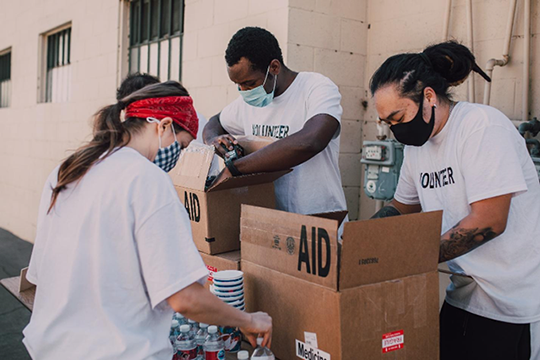How Does Community Engagement Help During Disaster Restoration?
 Santa Clarita is at high risk of earthquakes, its index rating more than double of California at 51.31. Natural disasters are always challenging because they require more than simple disaster restoration. They shake up communities and leave nothing but destruction in their wake.
Santa Clarita is at high risk of earthquakes, its index rating more than double of California at 51.31. Natural disasters are always challenging because they require more than simple disaster restoration. They shake up communities and leave nothing but destruction in their wake.
There is a need for immediate and extensive restoration work to return infrastructure, homes, and amenities to normal, but that’s not the only concern. Restoration teams also need to acknowledge the disaster’s impact on the community’s overall well-being and provide relevant support.
This blog outlines the impact of natural disasters on communities and explains how engagement can support recovery.
Impact of Natural Disasters on a Community
The first thing anyone thinks about when they hear about natural disasters is the physical destruction of properties. Although that is one of the most prominent problems, several underlying issues further plummet the affected community.
Following are some of the major problems a community faces:
1. Emotional Trauma
Surviving a natural disaster is a traumatic experience, especially if it causes widespread destruction and mayhem. People often become trapped, lose their loved ones, or see everything they have worked towards get destroyed in the blink of an eye.
Such experiences are difficult to forget, and people often find it difficult to get past them independently. The only hope for improvement lies in professional or community intervention, an essential part of achieving normalcy after a disaster.
2. Financial Distress
A house is a significant investment, and people often use up all their savings to buy one. It contains most of the things they own; therefore, a massive disaster can push them into severe financial distress.
Although insurance companies cover disaster restoration, coverage depends extensively on the plan. Additionally, some items are part of rare collections and cannot be replaced or compensated for.
Overall, natural disasters take a significant toll on a person’s finances, and they struggle to manage their assets.
3. Uncertainty
Natural disasters are followed by waves of uncertainty, especially if the region is at high risk. The problem with community-wide uncertainty is that it often induces unnecessary panic and propagates distrust between members.
Such states are unsustainable in the long run and need to be dealt with properly to prevent future issues.
4. Lack of Resource Availability
Natural disasters are unpredictable, and many have caused victims at the epicenter to become stranded. The destruction cuts off access routes to the affected areas, making it difficult for people to receive necessary resources and relief.
Such problems occurring on top of the overall crisis make things worse for the community and spread panic and despair. It can also cause members to turn on each other out of desperation, which can worsen the emotional state of the community in general.
How Community Engagement Helps During Disaster Restoration
Restoration experts are often so caught up with clearing rubble and repairing that they often neglect the emotional needs of the community. However, adopting this strategy is unsustainable, as it will likely prevent overall recovery efforts and rehabilitation.
The 911 Restoration of Santa Clarita understands the need for community engagement during disaster restoration. Following are the key ways community engagement can help during disaster restoration operations:
1. Creates a Network of Emotional Support
Community engagement focuses on creating an emotional support network that includes members, mental health experts, and restoration teams. The purpose of the network is to make sense of belonging for everyone to allow people to share their feelings of sadness and despair.
The less burdened they feel emotionally, the quicker their healing would be. Such recovery is necessary for members’ overall well-being, especially when recovering from a natural disaster.
2. Donations and Contributions
Several organizations and individuals set up charities and donations to support the worst affected members of the community to get back on their feet. While the monetary contributions cannot compensate for the loss of memorable belongings, they can pay for restoration the insurance doesn’t cover.
Monetary aid is also critical for covering healthcare costs that might emerge due to injuries sustained during the disaster. Such actions are essential for community restoration and healing because they ensure everyone receives the support they need.
3. Optimal Organization of Disaster Relief
The inaccessibility of essential resources like food and clean water is one of the worst challenges affected communities face after a natural disaster. It is also the primary cause of uncertainty that spreads through the people and creates internal rifts.
Community engagement and resource mobilization during disaster restoration are the best solutions for this problem. Aid groups, charities, and community volunteers connect and try to close need gaps through careful arrangement and distribution of free resources.
The idea is to stabilize efforts until more sophisticated help arrives.
4. Collective Efforts to Ensure Well-Being
Community engagement is critical for ensuring the collective well-being of all members. People within the same community often have vastly different backgrounds, which means there is a disparity in how people are affected.
The role of community engagement is to understand these differences, distribute assistance fairly, and support rehabilitation efforts.
Final Thoughts
In short, community engagement and disaster restoration go hand in hand. One manages the physical restoration of properties and infrastructure, while the other supports community rehabilitation and well-being.
The 911 Restoration of Santa Clarita team is an expert in all aspects of disaster restoration. Please do not hesitate to contact our teams or call us at (661) 401-7302 for emergencies.



